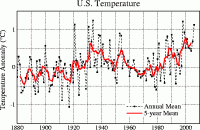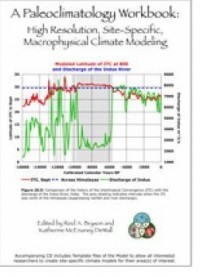
|
Aug 14, 2007
Inside the Beltway - Evidence That It has Happened Before
By John McCaslin, Washington Times
D.C. resident John Lockwood was conducting research at the Library of Congress and came across an intriguing Page 2 headline in the Nov. 2, 1922 edition of The Washington Post: “Arctic Ocean Getting Warm; Seals Vanish and Icebergs Melt.” The 1922 article, obtained by Inside the Beltway, goes on to mention “great masses of ice have now been replaced by moraines of earth and stones,” and “at many points well-known glaciers have entirely disappeared.”
“This was one of several such articles I have found at the Library of Congress for the 1920s and 1930s,” says Mr. Lockwood. “I had read of the just-released NASA estimates, that four of the 10 hottest years in the U.S. were actually in the 1930s, with 1934 the hottest of all.”

Read more here.
Aug 14, 2007
Scientific Consensus’ Not Represented in the IPCC Documents
By Madhav Khandehar in the Hill Times
Brant Boucher, in his letter “Scientific consensus” (The Hill Times, Aug. 6, 2007), seems to naively believe that the climate change science espoused in the Intergovernmental Panel on Climate Change IPCC documents represents “scientific consensus.” Nothing could be further than the truth!
As one of the invited expert reviewers for the 2007 IPCC documents, I have pointed out the flawed review process used by the IPCC scientists in one of my letters (The Hill Times, May 28, 2007). I have also pointed out in my letter that an increasing number of scientists are now questioning the hypothesis of GHG-induced warming of the earth’s surface and suggesting a stronger impact of solar variability and large-scale atmospheric circulation patterns on the observed temperature increase than previously believed.
I would further politely ask Mr. Boucher to do a simple reality check regarding the earth’s temperature change. Since mid-1998, the earth’s mean temperature as a whole has not increased at all, despite billions of tonnes of human-added CO2 in the earth’s atmosphere. Read more here.
Aug 12, 2007
Heretical Thoughts about Science and Society
By Freeman Dyson, Professor of Physics at the Institute for Advanced Study, in Princeton
My first heresy says that all the fuss about global warming is grossly exaggerated. Here I am opposing the holy brotherhood of climate model experts and the crowd of deluded citizens who believe the numbers predicted by the computer models. Of course, they say, I have no degree in meteorology and I am therefore not qualified to speak. But I have studied the climate models and I know what they can do. The models solve the equations of fluid dynamics, and they do a very good job of describing the fluid motions of the atmosphere and the oceans. They do a very poor job of describing the clouds, the dust, the chemistry and the biology of fields and farms and forests. They do not begin to describe the real world that we live in. The real world is muddy and messy and full of things that we do not yet understand. It is much easier for a scientist to sit in an air-conditioned building and run computer models, than to put on winter clothes and measure what is really happening outside in the swamps and the clouds. That is why the climate model experts end up believing their own models. Read more here.
Aug 11, 2007
A Paleoclimatology Workbook & Template CD
By Dr. Reid A. Bryson and Katherine McEnaney DeWall
Global warming? To understand the future, we must first understand the past. Whether you believe in global warming or not, you must own this workbook! This volume details the structure of the Macrophysical Climate Model (MCM), its origin, and how to apply it to your specific area(s)of interest. The MCM produces site-specific, 100-year resolution, models of the past monthly climate of an area (precipitation, temperature, evaporation, snowfall, precipitation intensity, and more). This workbook includes all you need to know to produce models for your specific area(s) of interest with the user-friendly model templates on the CD. There is also a section of case study applications of model results to understanding past climates and cultures.

The workbook will also be used at the upcoming Paleoclimate Workshop at the Mammoth Site of Hot Springs, SD, September 22-25, 2007. Dr. Bryson will be giving a public lecture the evening of the 22nd. See more here.
Aug 10, 2007
Understanding California Weather Patterns
By Jim Goodridge, Retired California State Climaologist
The evidence for a major climate shift since the mid 1970s is quite real. California indices of rainfall and temperature have both shown an increasing trend since 1975.
Physical changes in Earth weather systems that accompany the 1975 weather trend changes include the Pacific Decadal Oscillation (PDO) index, a 1975 change in the Atmospheric Angular Momentum (AAM) index and a 1940 increase in solar irradiance. Note: a detailed discussion of these factors and the contamination by urbanization follows in this excellent analysis.
The preservation and protection of temperature measuring sites needs to be considered. The future of temperature measurement in urban regions is fast being modified by urban growth. Waste heat and environmental changes are underway at the present time. A question is; at what distance from a waste heat source is the temperature measurements being modified and how much? A monitoring program for temperatures in areas free of land use change and waste heat is much needed. Perhaps areas dedicated to no development like parks would be ideal monitoring sites for temperature measuring. Read full analysis here.
|
|
|
|




